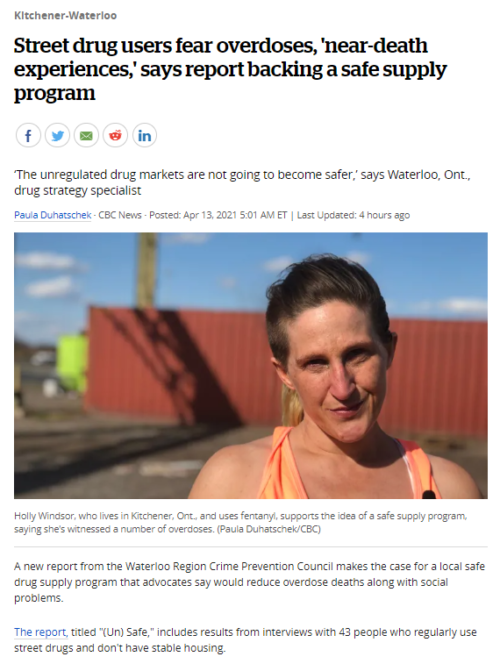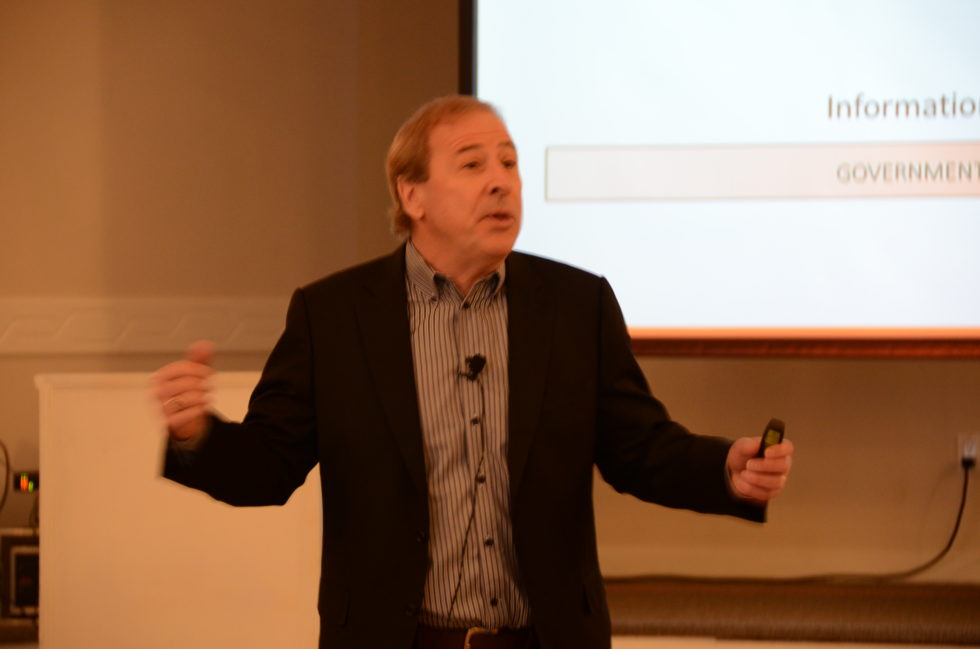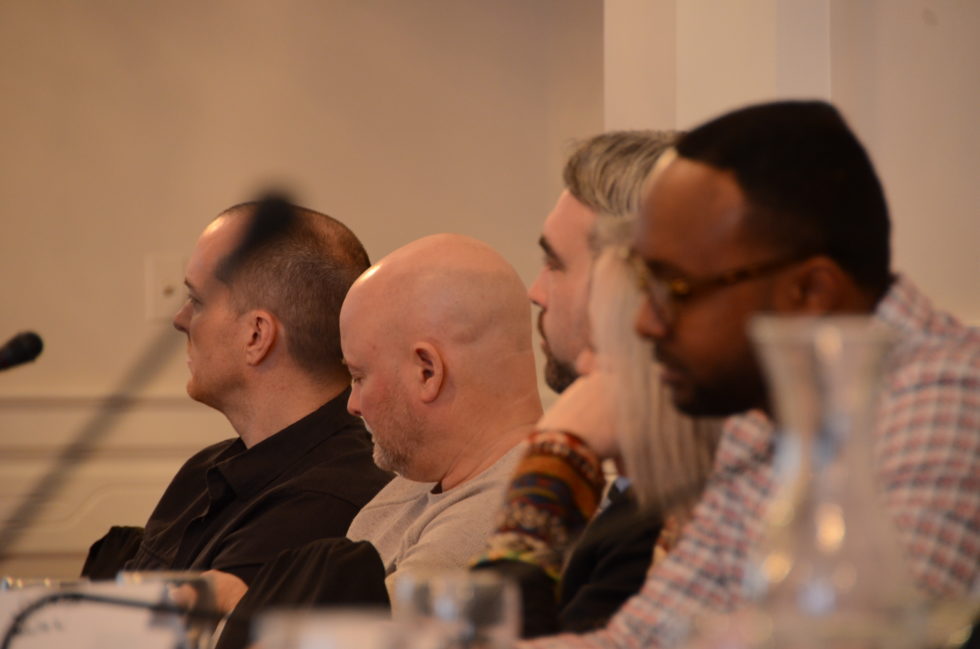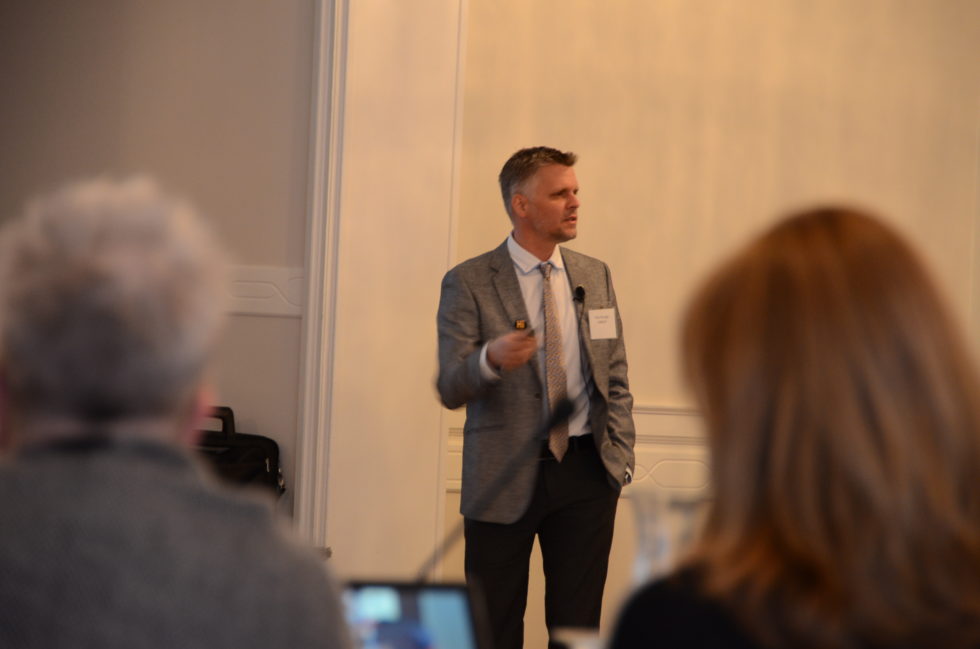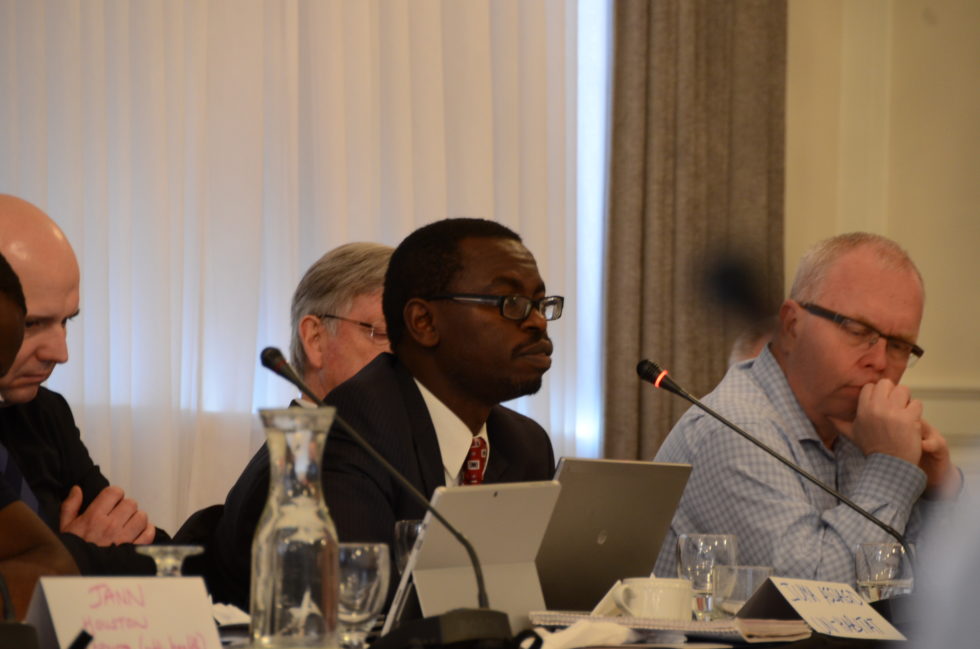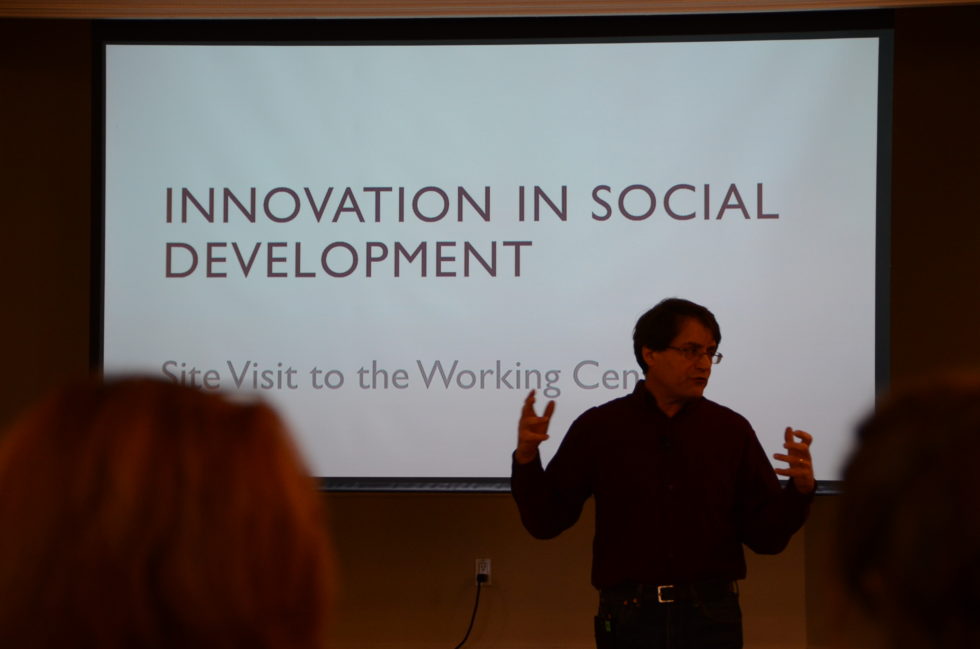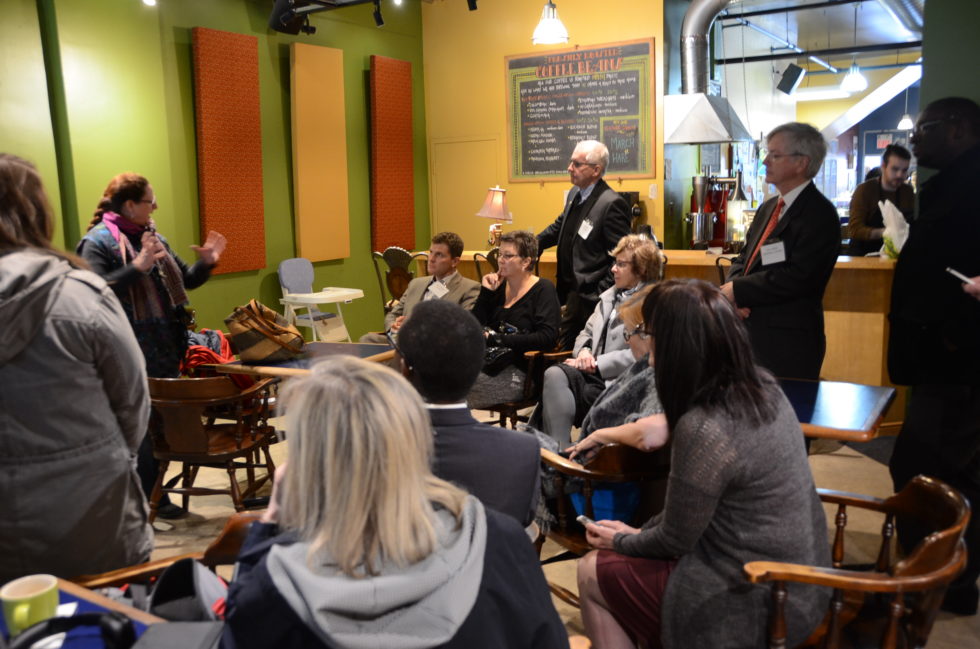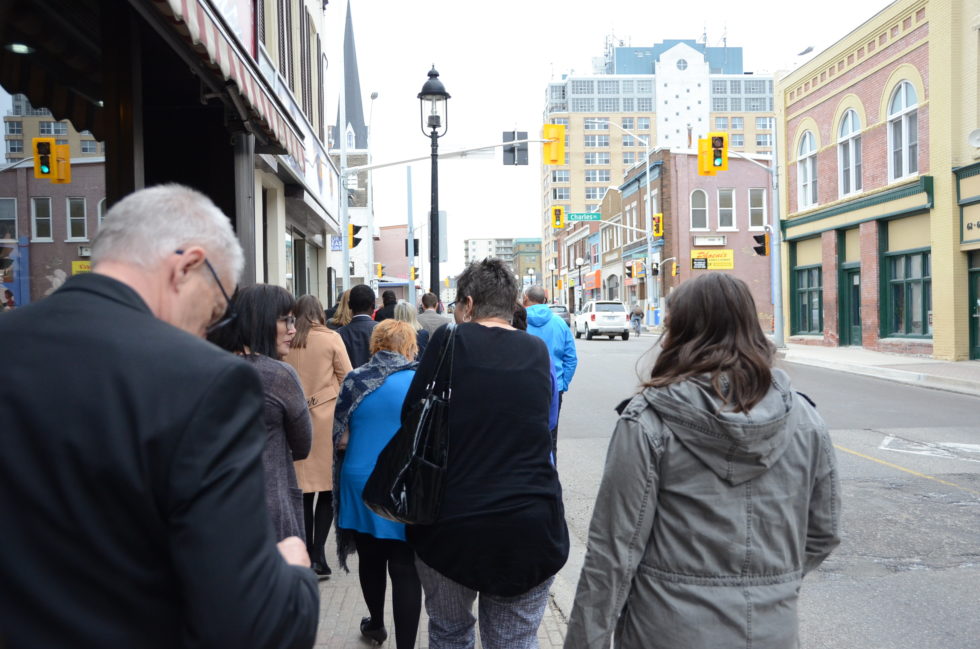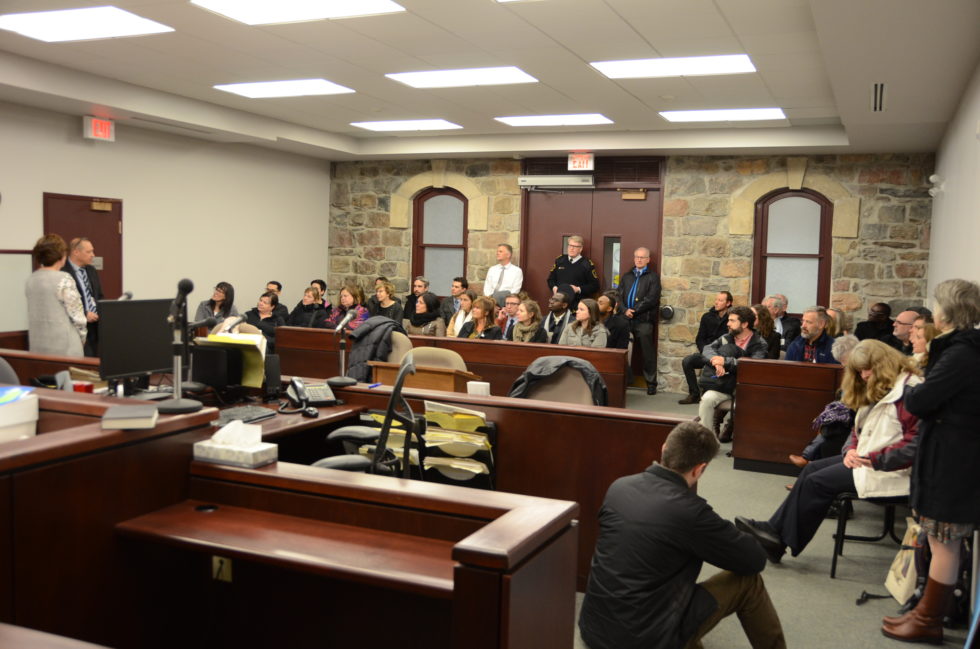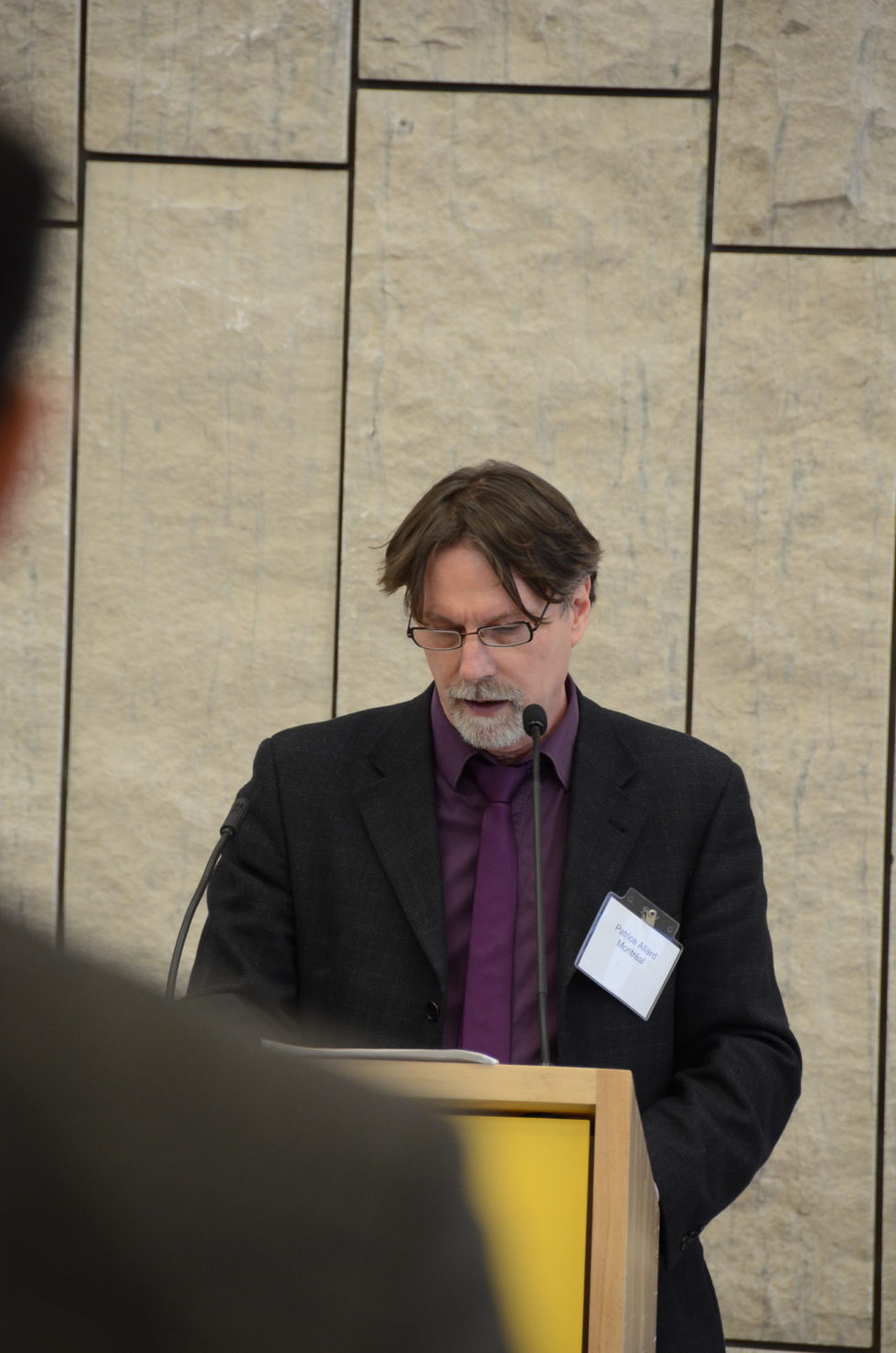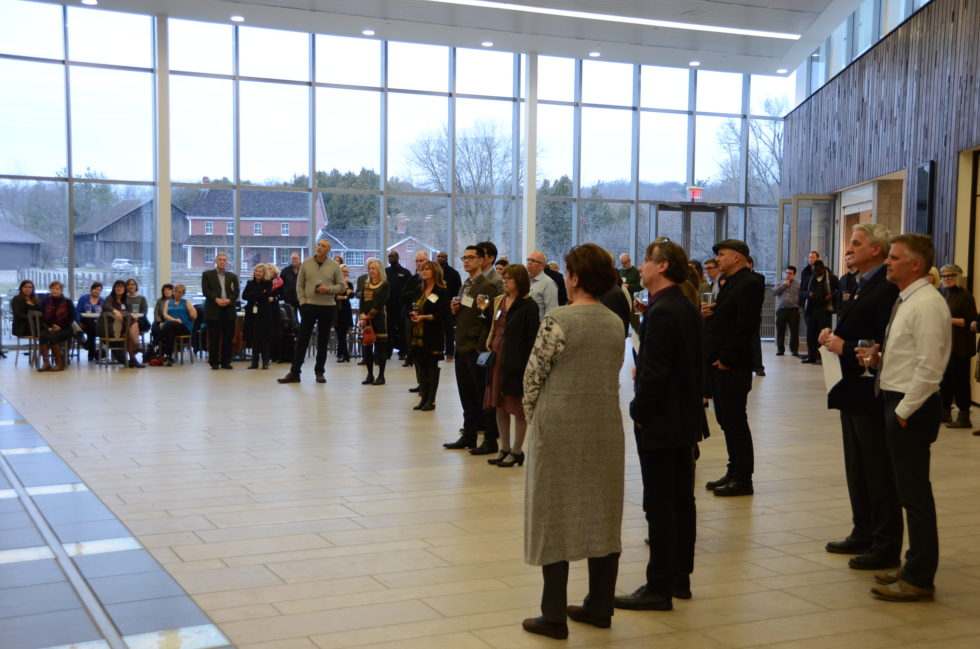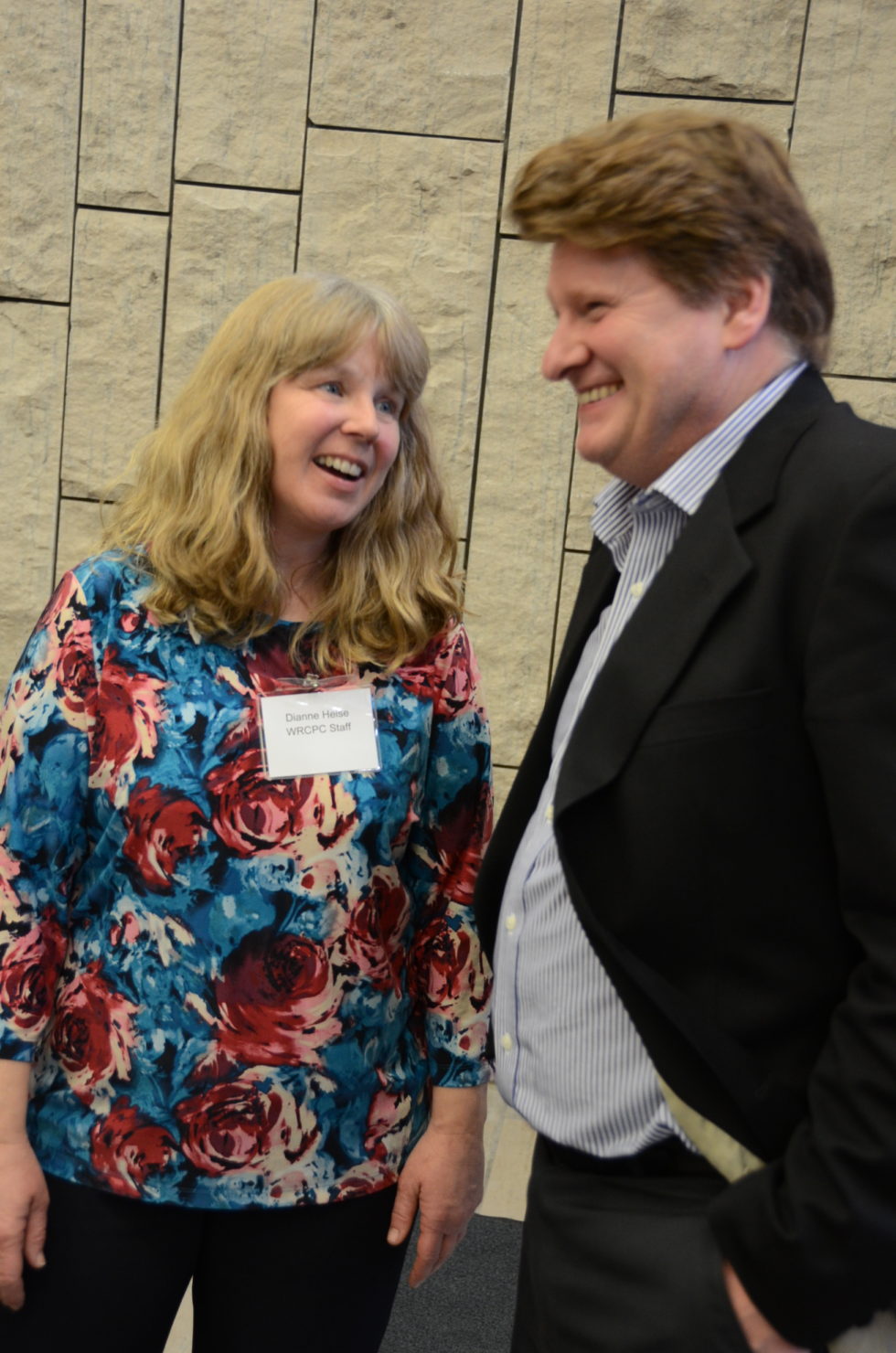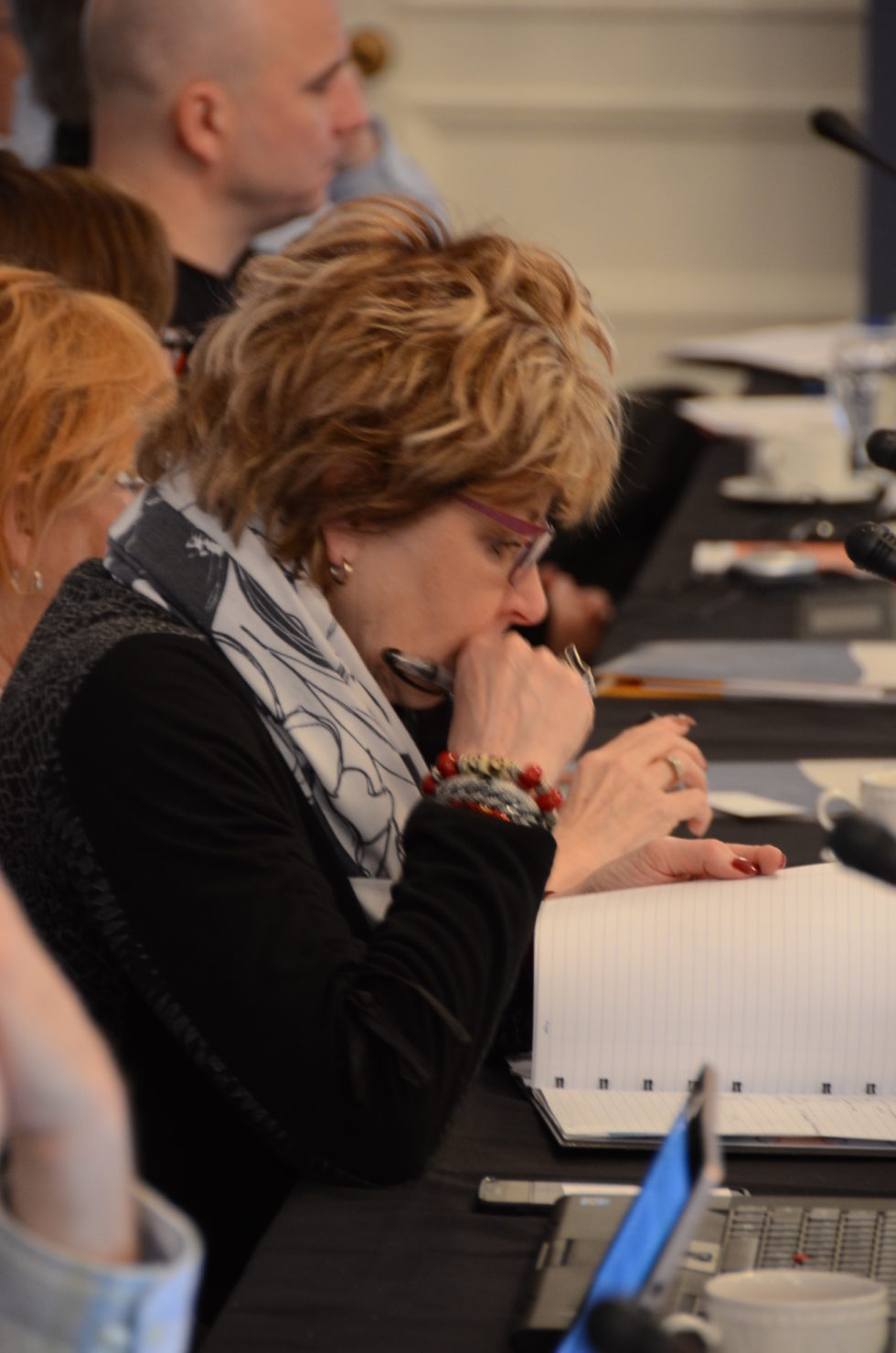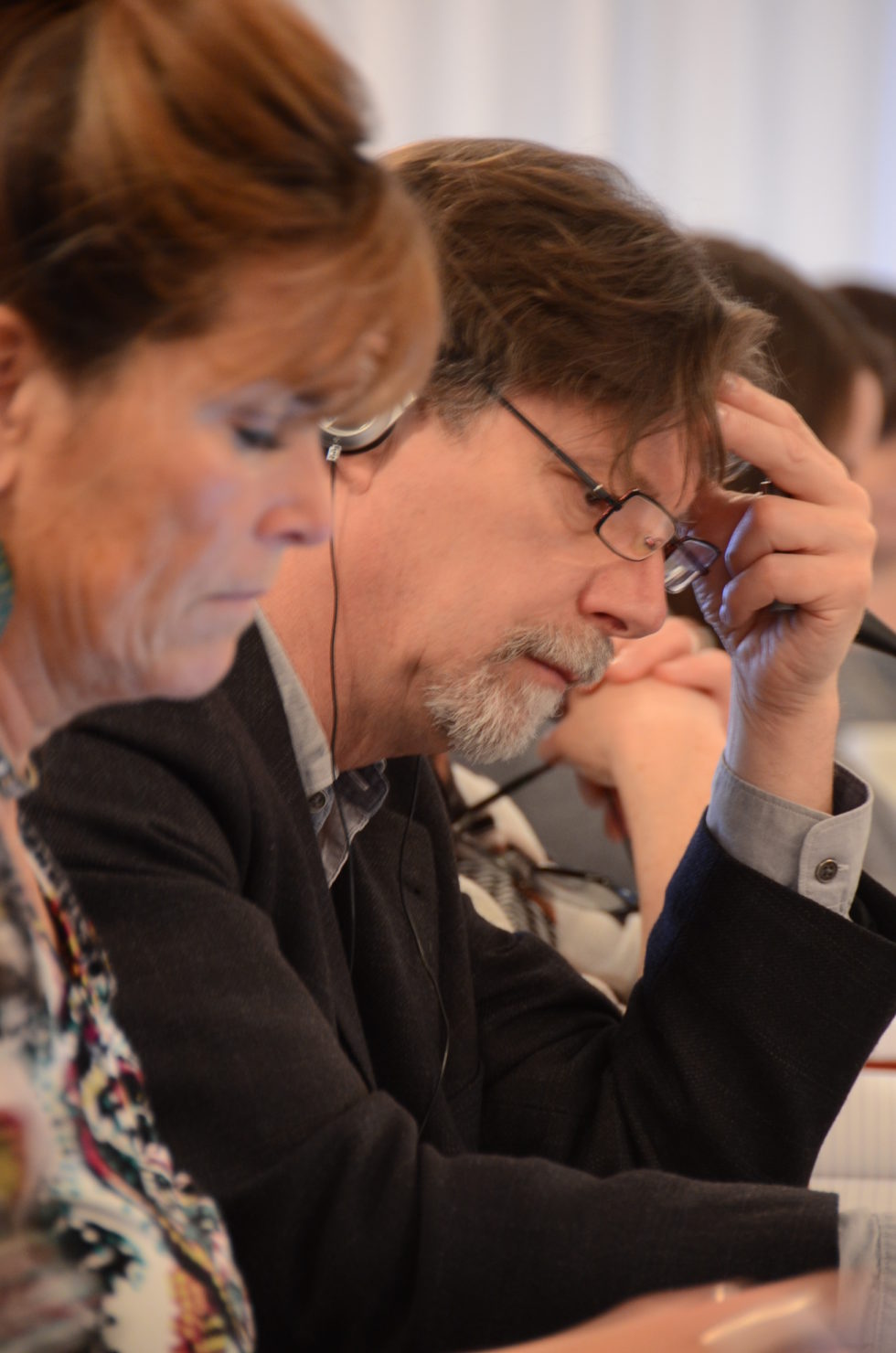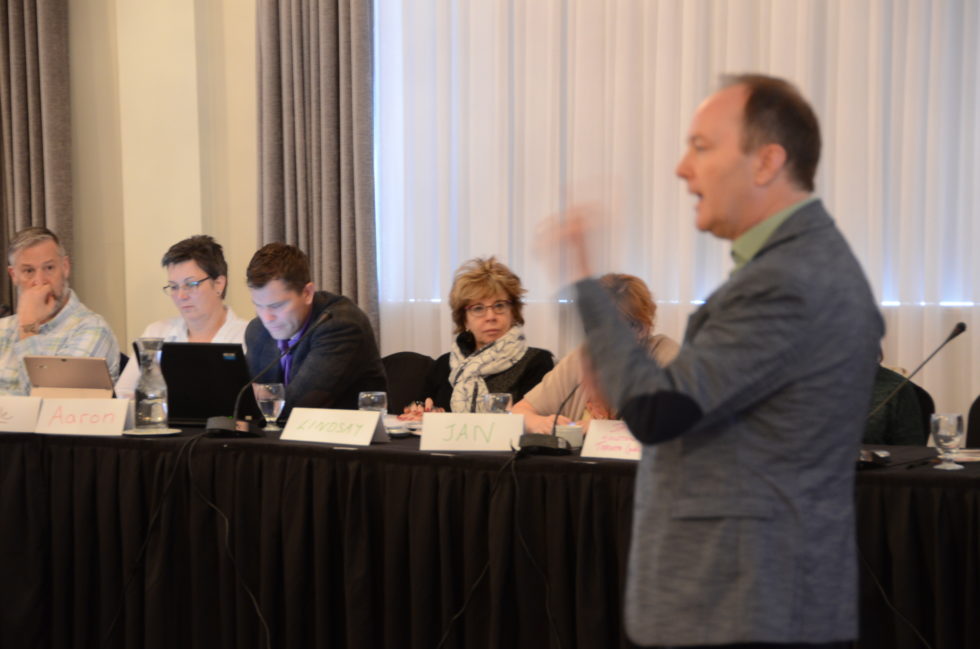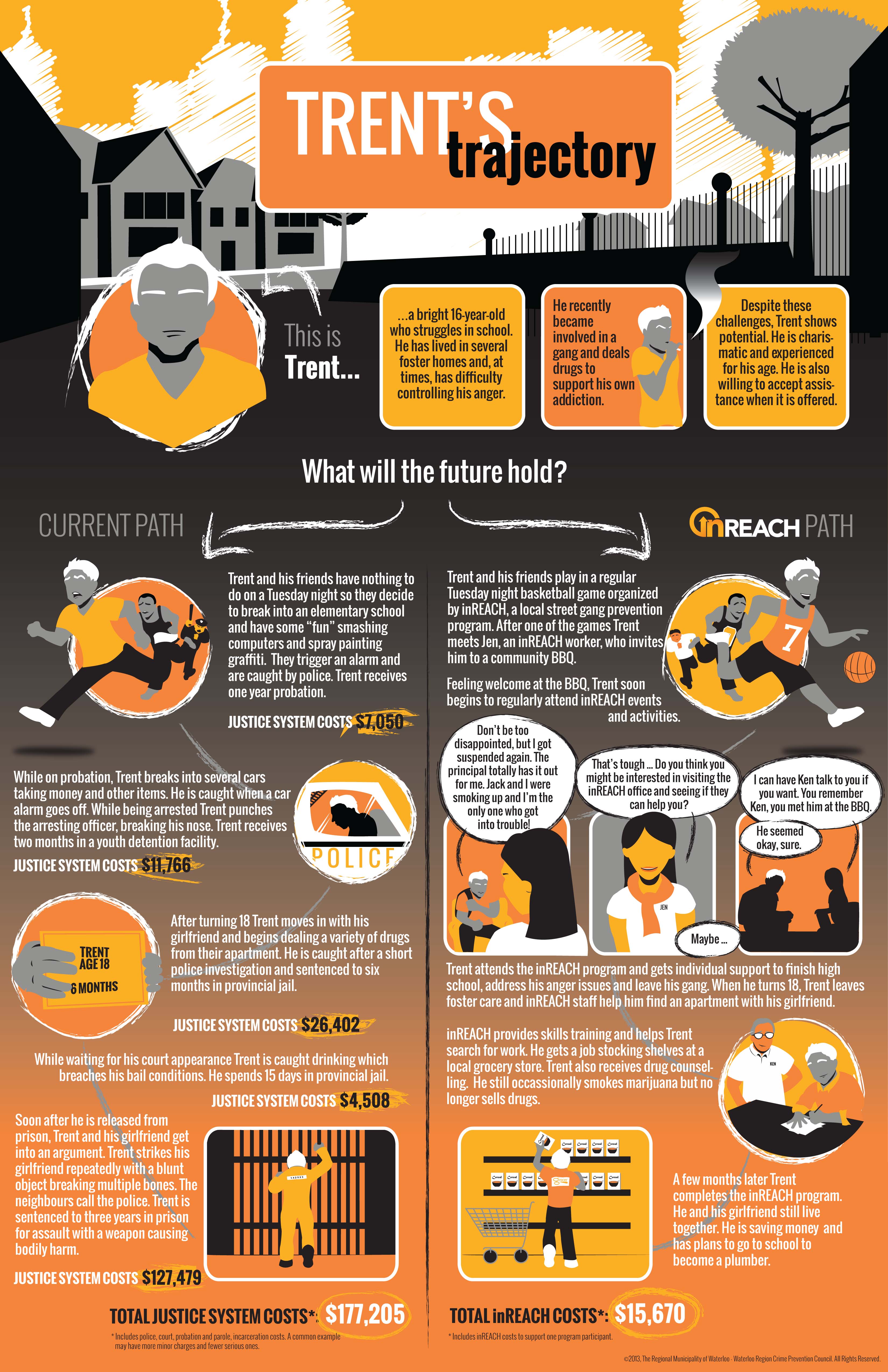Posts Tagged ‘crime prevention’
WRCPC hosts Canadian Municipal Network on Crime Prevention for national event
On March 30th and 31st 2017, the Waterloo Region Crime Prevention Council hosted the 2017 Canadian Municipal Network on Crime Prevention (CMNCP) at the Walper Hotel. During this two-day event, members of the network, representing 24 different municipalities across the nation, attended interactive lectures led by leaders in public engagement, mental health, and community development. They participated in round table discussions pertaining to increasing both the capacity for crime prevention as a whole and the CMNCP capacity.
Attendees also had the chance to network with other members regarding their experiences with crime prevention in their own municipalities. It was a pleasure to host this hardworking group here in Waterloo Region. We look forward to the continued work ahead!

The attending CMNCP members at the reception hosted by Waterloo Region Chair, Ken Seiling. -Waterloo Region Museum.
A few additional photos of the event proceedings
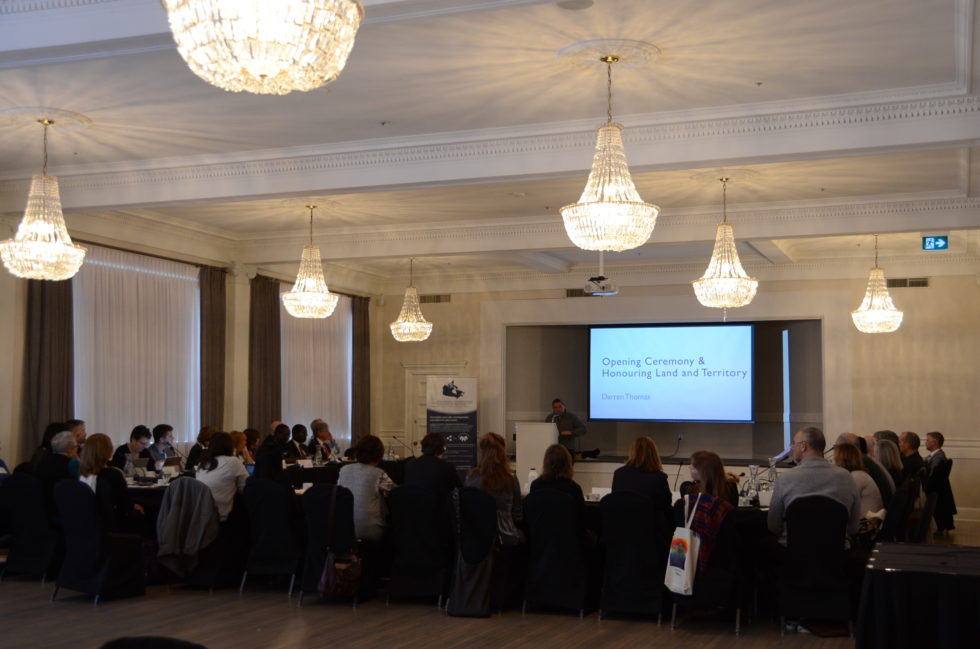
The CMNCP National Meeting was kicked off with an Indigenous Welcome & land Acknowledgement by Darren Thomas
Human Library ‘Books’ to Check Out at Friends of Crime Prevention
 As we put the finishing touches on the Friends of Crime Prevention Human Library event, we wanted to share some of the human ‘books’ and ‘library subjects’ you will find that day! Such a rich diversity of experience, knowledge and community change! You will have to use your time wisely to visit even three of these fantastic books.
As we put the finishing touches on the Friends of Crime Prevention Human Library event, we wanted to share some of the human ‘books’ and ‘library subjects’ you will find that day! Such a rich diversity of experience, knowledge and community change! You will have to use your time wisely to visit even three of these fantastic books.
On poverty/inequality:
- Greg deGroot-Maggetti, Living Wage Waterloo Region & Walking with People in Poverty Program Coordinator, Mennonite Central Committee
- Douglas Bartholomew-Sanders, Commissioner Community Services, Region of Waterloo & Ex-Officio member of WRCPC
On problematic substance use:
- Paul Gregory, Coordinator, Waterloo Region Integrated Drugs Strategy
- Michael Beazely, Associate Professor & Associate Director, Curriculum, University of Waterloo School of Pharmacy & Education (Post-Secondary) sector representative for WRCPC
On neighbourhood environments:
- Courtney Didier, Executive Director, Alison Neighbourhood Community Centre
- Laurie Strome, Community Leader & Volunteer, Sunnydale Community Association
- Both Laurie & Courtney are Neighbourhood Development sector representatives for WRCPC
On family environments:
- Karen Spencer, Director of Client Services, Family & Children Services of Waterloo Region
- Mary Zilney, Executive Director, Women’s Crisis Services of Waterloo Region & Domestic Violence Response sector representative for WRCPC
On mental health:
- Don Roth, Director of Services, Canadian Mental Health Association Waterloo Wellington Dufferin & Mental Health (Adult) sector representative for WRCPC
- Nellie Manley, Director Community Services and Housing, Waterloo Region Homes for Mental Health
On housing:
- Cheryl Grove, Social Planner on Housing Stability, Region of Waterloo
- Lynn Macaulay, Housing and Homelessness Umbrella Group (HHUG) Coordinator, Lutherwood
On youth support & engagement:
- Marla Pender, Youth Coordinator, City of Kitchener & Youth sector representative for WRCPC
- John Shewchuk, Chief Managing Officer, Waterloo Catholic District School Board & Education sector representative for WRCPC
- Peter Rubenschuh, Waterloo Region District School Board, Superintendent of Student Achievement and Well-Being & Education sector representative for WRCPC
What a collection!
Friday November 13, 2015
School of Social Work, Lyle Hallman Building
120 Duke Street West, Kitchener
(paid parking available at Kitchener City Hall. Entrance on Young Street, just across the street from the School of Social Work)
9:00 – 11:30 a.m.
Join us at 8:30 a.m. for our famous coffee social!
Friends of Crime Prevention Human Library: The Root Causes of Crime Edition
If you had the chance…. What questions would you ask from long time community leaders and pioneers in the field of crime prevention in Waterloo Region?
Don’t miss your opportunity with the Friends of Crime Prevention Root Causes of Crime Human Library!
Friday November 13, 2015
School of Social Work, Lyle Hallman Building
120 Duke Street West, Kitchener
9:00 – 11:30 a.m.
Join us at 8:30 a.m. for our famous coffee social!
Preview the list of “subjects” you can check out at the event – what a collection!
This year, 2015, marks the 20th Anniversary of the Waterloo Region Crime Prevention and 20 years of prevention-based thinking about crime prevention through social development.
At our Friends of Crime Prevention event on Friday November 13th, we take a look back at how we and our community have evolved, adapted and lead the way for change on the root causes of crime as a community in Waterloo Region.
In 1996, WRCPC developed The Root Causes of Crime statement as a way to promote a better understanding of the root causes, as complex and interrelated as they are. Earlier this year, WRCPC consulted with our community to guide the development of our 2015 – 2018 strategic plan. We learned that people generally understand the root causes of crime and victimization – which is amazing! The conditions we knew to contribute to crime 20 years ago were identified again today as priority root cause areas in need of focused attention. These include:
- poverty/inequality
- problematic substance use
- neighbourhood environments
- family environments
- mental health
- lack of housing
- lack of supports & engagement for youth
Join your fellow Friends of Crime Prevention for this chance to ‘check out’ and ask questions of our ‘human library books’. Find out what is happening in our community to address these root cause issues, what organizations are involved in the work, what the issues and solutions might be and discover potential opportunities for Friends to get involved!
For more information, contact:
Juanita Metzger 519.575.4400 ext. 3548
By the numbers: Homicide rates in Waterloo Region
Despite homicide being a rare event in Canada, when it happens, it is the highlight of media headlines. Television news, newspapers, and social media sources all follow the story closely. In parallel to media coverage, there is a steady growth of stories being told about crime. These are found in popular novels writing about true crimes and television dramas sensationalizing the role of police and courts. With all of this attention on crime, it might be fair to imagine that consumers’ craving for violent crime related publications and or news drives its unproportioned publicity and its media focus, however, it is much more complicated to figure out which one comes first.
Homicides attract a great deal of media attention but it’s important to remember that they make up less than 1% of all violent crimes. Although homicide rates decreased last year, the homicides that did occur were heavily reported. The media focus on violent crimes, like homicide, has a great effect on the perceptions of ordinary citizens that leads to inaccurate beliefs that crime has increased. This influence of media on perceptions of crime is evident among the citizens of Waterloo Region. For instance, in the report, Won’t you be My Neighbour, the WRCPC used survey data from 2012 to show that 61% of the respondents think there is more crime Waterloo region today than when they were a child. In addition one-third of Waterloo Region residents think crime has increased over the past five years. This is despite the crime rate having dropped dramatically over the past 25 years in Canada and Waterloo Region. When news media use inflammatory language for front page headlines this can incite fear among readers and viewers and have a profound influence on the public’s perception of violent crimes including homicide.
The rate of homicide in Canada has been in steady decline since the 1980s. In 2013, there were 505 homicides in Canada, 38 homicides fewer than the previous year, marking an 8% decrease in the homicide rate (1.44 per 100,000 population). The homicide rate has generally been decreasing since peaking in the mid-1970s. (see Figure 1- homicide rates 1963 to 2013)
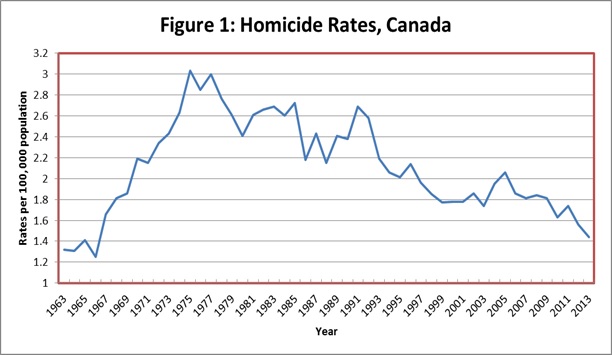
Source(s): Data on homicide are available back to 1961 in CANSIM table 253-0001.
Homicide, police-reported homicide rates, by province and territory, 2012 and 2013
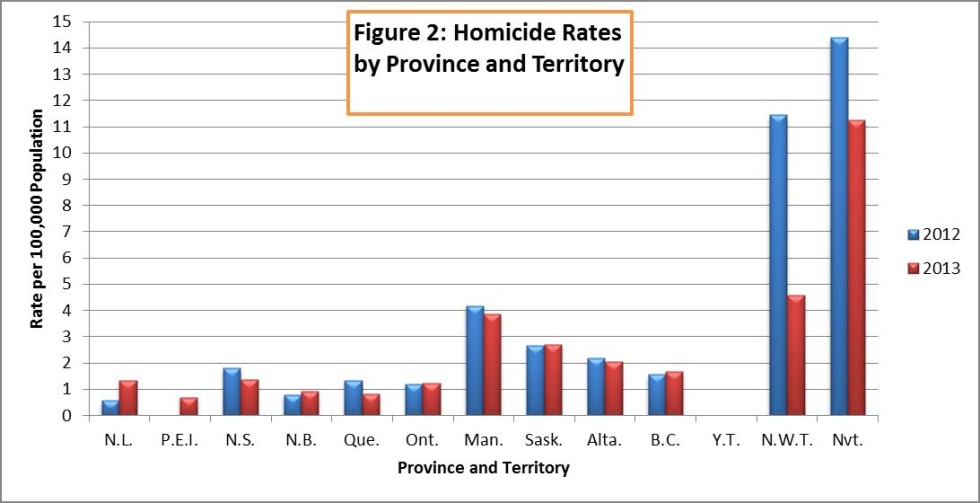
Among the provinces of Canada, British Colombia, Ontario and Newfoundland and Labrador, saw a marginal increase in homicide numbers in 2013. On the other hand, Quebec saw 40 less homicides in 2013 than in 2012. Yukon was the only jurisdiction to report no homicides (See Figure 2). Overall, the number of homicides in Canada continued to decline as of 2013 across most provinces and territories and most census metropolitan areas.
Against this backdrop, crime in Waterloo Region in 2013 showed a one year blip where our homicide rate rose above the Canadian average. From 1981 to 2013 there were 171 homicides in the Kitchener-Cambridge-Waterloo CMA; that’s an average of 5 per year. Looking just at one year snap shots though we see the number rise to as high as 11 and drop to as low as one. A wide fluctuation like this does not mean we should panic if the rate shows a one year blip, nor should we dismiss homicides as a possibility in times when the rate drops. What’s import to examine is the trend over time, which is declining in Waterloo Region just like it is declining in Canada (Figure 3).
Homicide, police-reported rates, Canada, Kitchener/Waterloo/Cambridge – 1981 to 2013
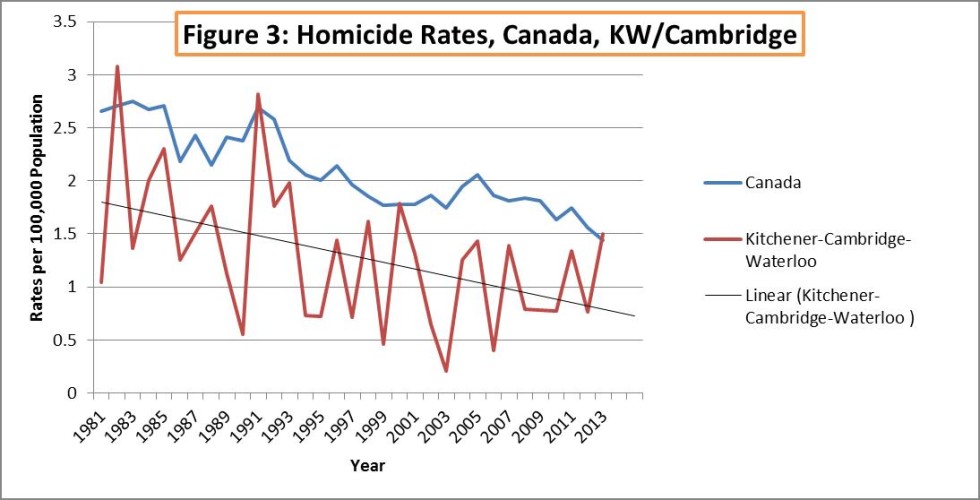
Source: Statistics Canada, Homicide Survey, Canadian Centre for Justice Statistics.
As shown above, the rate of homicides in Waterloo Region rose above the national average in 1982, 1991, 2000, and 2013. Although the increases of the homicide rate in these four years seems alarming, in every other year, stretching 32 years of homicide rate, it was consistently lower than the national average. Waterloo Region is a safe place to live with relatively few homicides. On the other hand, although the Region has a low homicide rate, one major incident can affect the statistical rates and the publication of the event with sensational headlines could incite fear among readers and viewers and potentially trigger unfounded perceptions of crime being on the rise in our community.
What do you think is a good measure of safety in our community?
Author: Asnake Meshesha is a Master of Social Work placement student with the Waterloo Region Crime Prevention Council.
On a February night in 1995…..
Maybe even much like February 3rd, 2015… cold, crisp and clear, with a bright full moon.
A group of enthusiastic and passionate community leaders presented the work of the Community Safety and Crime Prevention Council to Waterloo Region Council. At the time, they had been operating for almost 2 years! Their proposal on February 3rd, 1995 was to evolve from a ‘task group’ to a more formal entity, with a paid staff!
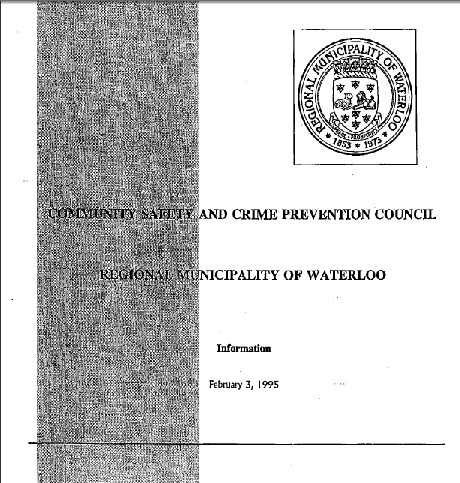

Looking back can be informative… and sometimes cringe worthy! In 20 years, our language and conceptions about crime and crime prevention have evolved so much!
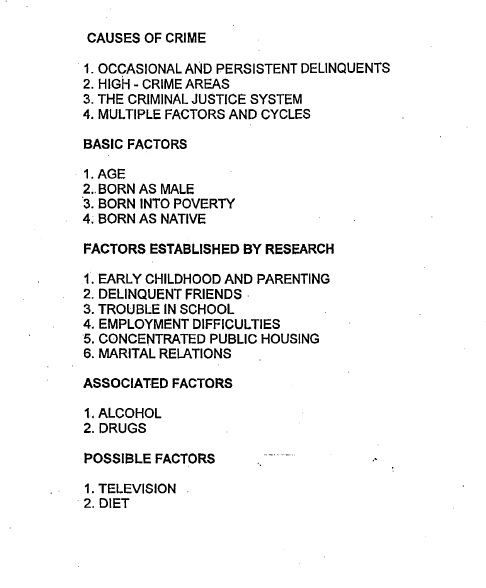

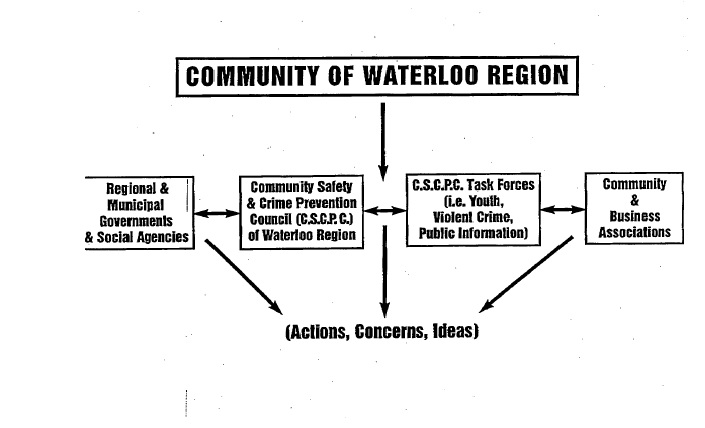
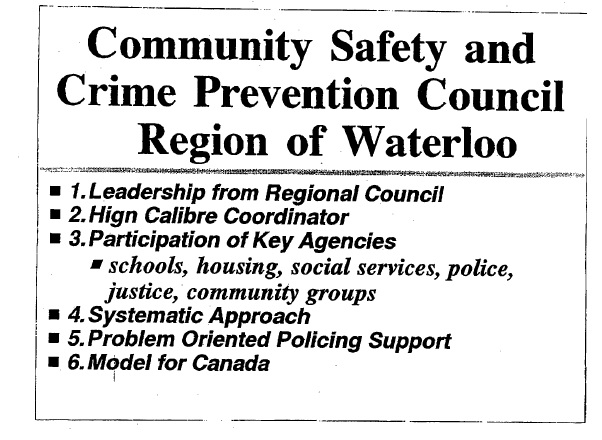
Did you catch point number two?? High calibre coordinator! That’s our very own Christiane Sadeler. She’s still the Executive Director to this day.
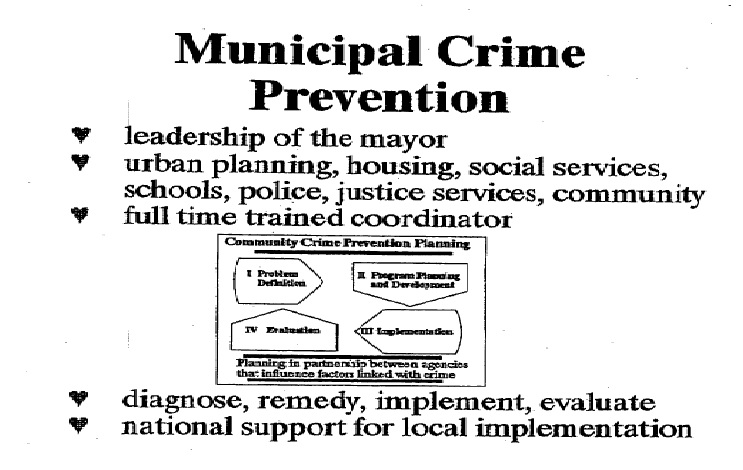
Love the heart bullet points!
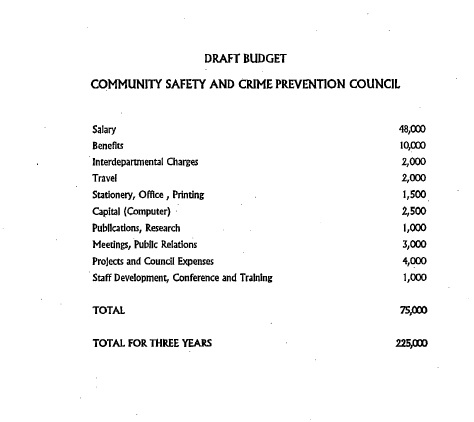
Well, there you have it folks, the presentation that launched a crime prevention through social development initiative in Waterloo Region, to the tune of $225,000 over 3 years. Such incredible growth and change over 20 years. If we had a spare $225,000 now…. well, we could do a lot of things. But one thing we would do is hire a really brilliant evaluator to capture and measure the trajectory of community change over the course of 20 years as a result of this thing we now know as the Waterloo Region Crime Prevention Council.
Can you imagine the things we would learn?
Has the WRCPC made a lasting impression on our community? What is that to you or your organization?
Best of the Blog: Our top 14 of 2014
We’ve been in reflection mode this week at the WRCPC office. The time of year lends itself perfectly to this kind of ‘look back’ at the year that was 2014. I hope you are enjoying your own reflections. And, since we’re at it, why don’t we do some reflecting together, with the help of Smart on Crime.
We had such a variety of blog posts this year, ranging from what we were reading to crime stats, to special posts from Friends of Crime Prevention. Early in 2014, we wrapped up a year long examination of the root causes of crime. With the end of inREACH in Waterloo Region, we took some time to share what our community has learned from inREACH and engage our community in a follow up event in April where planned next steps. We even introduced you to some new words to enrich your vocabulary! And of course, we couldn’t help but challenge our community with some harder hitting posts.
Our readers are as diverse as our blog posts, which would explain the diversity of popular blogs this year. Here’s the round up of our top 14 posts from 2014.
- Public Opinion & Crime – Anthony Piscitelli
“Since 2006 the Canadian government has focused on being tough on crime. The policy approach continues to this day but it seems the Canadian public is starting to see these changes as a policy excess. Instead of focusing on punishment, public opinion polls suggest the government focus should be on prevention through education and social development programs.”
- A new story is needed – guest post by Friend of Crime Prevention, Doug McKlusky
“As a Friend of Crime Prevention, I believe that that the heart of crime prevention is through social and community development…..
Imagine neighbourhoods where everyone feels a sense of belonging, where inclusion trumps fear.
Imagine workplaces where people belong, and where respect and collaboration trump power and politics.
Imagine schools where belonging trumps bullying and streaming.”
- The new story continues…. – guest post by Friend of Crime Prevention, Doug McKlusky
“I do believe that many small actions will add up to a large action on the road to building a community of belonging. It can be as simple as acknowledging the presence of a homeless person in downtown Kitchener, they are part of our community, a friendly smile goes a long way in making a person feel like they belong. I challenge you to do something to make our community a community of belonging, smile at a stranger, volunteer somewhere in your community, it will make a difference, it will connect you!”
- Inspired by inREACH: Reflections of a youth outreach worker – Youth Outreach Worker, Krista McCann
“inREACH fostered a working environment that not only allowed us, but encouraged us to work outside of the box. I’d be lying to say the task was not daunting at first. In my previous experience working as a Youth Worker I had never been given such flexibility and confidence within a position to achieve the desired outcome; an outcome that was not based on the amount of programs ran or number of program participants but the ability to engage youth in their community.”
- Neighbourhood policing: A learning opportunity for Friends of Crime Prevention – WRCPC Student, Ryan Maharaj
“To usher in 2014, WRCPC hosted a learning event on ‘Neighbourhood Policing’. Naturally, Friends of Crime Prevention & WRCPC have a common interest with the police on all things related to crime prevention, community safety and well-being. Inspector Kevin Thaler from the Waterloo Regional Police Service was our guest to unveil the recent sweeping changes to their organizational structure, daily operations and dispatch methods. The results are what is now known as Neighbourhood Policing.”
- Between life and death: Responding to drug overdoses in Canada – former WRCPC student, Kayla Follet
This article appeared in the July 14, 2014 edition of the Waterloo Region Record.
- By the numbers: Wading through police-reported crime statistics 2013 – Anthony Piscitelli
“Statistics Canada released their annual Police-reported crime statistics 2013 report in July (and in French). There is always so much to sift through and interpret. Learn more from the Canadian Criminal Justice Association.”
- By the numbers: Hate crimes in Waterloo Region – Anthony Piscitelli
“In 2009, the Kitchener-Cambridge-Waterloo census metropolitan area (CMA) had the highest hate crime rate in Canada, according to police reported statistics. Did you catch the end of that sentence? “…..according to police reported statistics”. It might seem insignificant, but it might be the key to understanding why the 2009 hate crime rate in Waterloo Region is so high compared to other CMAs in Canada. “
- No clichés: A reflection on working with the youth of inREACH – guest post by Karl Garner
“Having been with inREACH, it became quite evident, that the youth we worked with often experienced clichés in their lives. They were labeled, stereotyped, and their behaviours were often predicted by the adult world around them, yet most of the time no one knew anything about them. Outside of where they lived, or who they hung out with, or the school they went to, or perhaps what they look like, do many even know these youth? The label which is the umbrella they live under is their cliché.”
- Ignoring what we’ve learned. Or, how to ensure street gangs become a real problem in Waterloo Region – Ryan Maharaj
“It’s easy to assume that we should apply what we’ve learned from the inREACH project to better support marginalized youth in our community. But have you every stopped to wonder, what happens if we ignore what we’ve learned? What if we shed the rose-coloured glasses and donned the shades of pessimism to see the barriers that stand in our way? What if we tried to see the glass half empty? How can we make a problem like street gangs in Waterloo Region, worse?”
“How do we get at the root causes of crime and prevent it from happening in the first place?
This isn’t a direct, straight answer, but, the Waterloo Region Crime Prevention Council believes part of the solution is to monitor the root causes of crime over time. Then we, as a community, can better understand and address the social, community and economic conditions associated with crime and victimization. Check out the Waterloo Region Crime Prevention Council’s report – A Snapshot in Time: The Root Causes of Crime in Waterloo Region to find out how we are doing in early childhood development, employment, community trust and other important indicators.”
….. and part 2 of The community weighs in on the root causes of crime: change and action
- Why communities need neighbourhood-based programming for youth – guest post by Courtney Didier, Alison Neighbourhood Community Centre
“We have worked with youth who have great dreams and aspirations for the future, but have trouble putting their vision into a workable plan. On the other side of the coin, we have worked with youth who have little to no confidence in their abilities, thus requiring a little more encouragement and a little more trial and error in determining what really gets them motivated and excited.”
- Lessons learned in a gang project – Dianne Heise and Rohan Thompson
“Gang Prevention Is…. a) addressing underlying issues, and, b) not about getting a kid to take off the bandana. We often heard – “we’ve got this kid, he’s in a gang – fix him.” So often in our case management and system navigation work, it wasn’t about getting this young person to take off his bandana or to stop hustling or whatever, we never approached the work in that fashion. But it was about the underlying issues and working on them. Mostly we were dealing with issues of poverty, untreated trauma, family breakdown, substance abuse, disengagement and lack of opportunities. These are the problems that young people and gang members and people in general are dealing with. We want to demystify that label of gang member that says their needs are different than any other groups. These same issues are the drivers behind the behaviours.”
So many great reads from 2014. But if you’re in the mood for something to watch, rather than read, might I suggest our newest video on Collaboration!
We look forward to bringing more great Smart on Crime blogs for you in 2015. Better yet, we love hearing your comments, reactions and responses to the posts and guest commentaries. We look forward to hearing more from you next year!
By the numbers: Hate crimes in Waterloo Region
In 2009, the Kitchener-Cambridge-Waterloo census metropolitan area (CMA) had the highest hate crime rate in Canada, according to police reported statistics. Did you catch the end of that sentence? “…..according to police reported statistics”. It might seem insignificant, but it might be the key to understanding why the 2009 hate crime rate in Waterloo Region is so high compared to other CMAs in Canada.
A criminal offence against a person or property is considered a hate crime when there is evidence that the offence was motivated by hate, based on the victim’s: race, ethnic origin, language, colour, religion, sex, age, mental or physical disability, sexual orientation, or other similar factors. In 2009, in Waterloo Region, Police identified 93 crimes that fit this definition. While the number doesn’t tell us the nature of these reported hate crimes, these 93 situations represent the number of crimes that came to the attention of police that were classified as hate crimes in 2009.
But before we jump to conclusions about Waterloo Region being a hot bed of hate and discrimination, we might want to take a look at other cities and regions. St. John’s, Saint John, Barrie and Thunder Bay reported zero hate crimes incidents in 2009 and Saguenay, Trois-Rivieres and Greater Sudbury reported one hate crime incident each. When it comes to any urban centre, we can be reasonably confident that zero or one hate crime per year might have more to say about what comes to the attention of police and how it is classified than reality.
What we might conclude from the Census Metropolitan report in 2009 is that the reporting approaches are at this time too diverse to portray an accurate cross city picture. Comparisons between jurisdictions require similar reporting standards and such consistency did not exist in 2009. Thus, higher numbers might point to a more rigorous reporting and/or greater community attention to an issue.
By just looking at the numbers alone, Kitchener-Waterloo was put on one of eight worst places in Canada to move to for immigrants. This use of data without context was easy to share as a quick sound bite, but provided a woefully inaccurate picture of the community.
But the report is not fully useless by any stretch of the imagination. What we can and should do is use the data to compare hate crime rates over time. Such comparison works on the assumption that Waterloo Regional Police Service are more or less consistent in how they define and report hate crimes from year to year. On that basis Waterloo Region saw a steady decline in hate crimes from 93 in 2009, to 55 in 2010, to 41 in 2011 and 30 in 2012. That is a promising emerging trend. There is a BUT…
One hate crime is simply one hate crime too many. Crime prevention and the creation of a peaceful (read “inclusive”) society are intimately linked. And there can be no peace without inclusion. Understanding the nature of hate crimes in Waterloo Region should be a critical next step in our shared goal of creating a community that is safe for everyone. Armed with information about who the victims of hate crimes are, who has committed the offences, and what trends we observe overall provides us with data that can help us to begin to prevent these crimes.
 In 2012, the KW Multicultural Centre, along with numerous community partners developed a series of workshops designed to help community members better understand hate crimes, learn how to recognize potential hate crimes, how to help victims and what to do in the event of witnessing an incident that might be a hate crime. The workshop materials were designed in a way that those who completed it could deliver the workshop to other groups. To date, more than 15 workshops have been conducted in our community with over 250 people taking the training. These and other efforts help to raise awareness about the importance of hate crime prevention.
In 2012, the KW Multicultural Centre, along with numerous community partners developed a series of workshops designed to help community members better understand hate crimes, learn how to recognize potential hate crimes, how to help victims and what to do in the event of witnessing an incident that might be a hate crime. The workshop materials were designed in a way that those who completed it could deliver the workshop to other groups. To date, more than 15 workshops have been conducted in our community with over 250 people taking the training. These and other efforts help to raise awareness about the importance of hate crime prevention.
In an effort to do our part and continue the dialogue and problem solving, the Waterloo Region Crime Prevention Council recently released a RAP Sheet on Hate Crimes. The RAP sheet contains a number of suggestions on “what you can do” to address and prevent hate crimes. We are also committed to continuing to watch the data and educate ourselves by speaking to those who have lived experiences. Watch this page and our website for information we gather and for what we are learning. Also watch for how you can stay or get involved.
Meanwhile, we are keen to learn what you think! We are especially keen to learn what ideas you have to prevent hate crime before it happens.
Author: Anthony Piscitelli is Supervisor, Planning & Research with the Waterloo Region Crime Prevention Council. He collaborates on all research efforts published by WRCPC.
Serving Time: Six months with the Waterloo Region Crime Prevention Council
Prior to my Master of Social Work student placement at the Waterloo Region Crime Prevention Council (WRCPC) in January of 2014 I had very little, if any, knowledge of the concept of ‘the root causes of crime’. I knew quite a bit about human development, that we are all products of our past experiences, and it was pretty clear that crime is likewise a result of countless influences; it is so much more than ‘bad people’ doing ‘bad things’. What we do and how we decide to act is dictated by all of the tiny events that make up our lives be they happy or sad, wonderful or traumatic, important or seemingly insignificant. The WRCPC addresses these root causes, this infinite web of experiences and events, to help prevent crime before it occurs.
So it sounds pretty simple right? Address the causes before they lead to trouble, is it really that revolutionary? After spending the past six months with this team I can say with conviction that yes, yes it is! There are so few organizations that dedicate their time and effort solely to the prevention of crime and the study of root causes of criminal activity. If you don’t believe me try to search ‘crime prevention’ or ‘root causes of crime’ in any major search engine and not find something about the WRCPC on the first page. Working with this organization has opened my eyes and, to borrow their phrase, I have a better understanding of how to be ‘smart on crime’. Now it is far easier for me to consider the whole picture rather than simply looking at the end result. Because crime is so complex and intricate, it requires equal complexity and intricacy in order to effectively address it.
If you will, I would like to share with you my understanding of what the WRCPC really is. Rather than explaining the organizational chart of the WRCPC, which, I am by no means an expert, this is a map of my experiences with the WRCPC. Becausethe majority of the work that the WRCPC does involves providing support, information, and networking opportunities for other human service organizations in the Region, they rarely get the chance to advertise the fantastic work that they do.
The following image is an embodiment of my experiences at the WRCPC. These are the things that I directly witnessed or had a role in completing during my stay and I am sure that I didn’t get it all.

Ryan’s Mind Map to illustrate how he understands crime prevention through social development.
The six staff members are the very foundation of the council, providing the nourishment and support that is needed to complete this vast array of work. Each member plays a significant role and sustains an entire branch of ‘crime prevention’. Christiane Sadeler is the bridge between the staff and the council itself (a body of impassioned community members representing the human services sectors throughout the Region). With this sturdy foundation of staff and council members all of the tremendous work is completed. From academic research to community engagement the WRCPC addresses ‘crime prevention’ from all angles.
It has been such a pleasure to work within this jumbled group. I have learned so much and had the pleasure of working with such meaningful and impactful projects. If you have never had the opportunity to work with crime prevention or just want to know more about what it means do what I did; become a Friend of Crime Prevention. Let’s attend a meeting and have a real discussion about the ways we can make our Region stronger, healthier, and happier. There is always more that can be done and my journey is nowhere near complete.
Author: Ryan Maharaj, MSW Student with WRCPC. Ryan recently moved to Waterloo in pursuit of his Masters in Social Work at Wilfird Laurier University. Placed at the Waterloo Region Crime Prevention Council, he has been given the opportunity to explore the role of male allies in the movement against sexual and intimate partner violence. He firmly believes that with respect, support, compassion, and education we can prevent the occurrences of sexual violence in the next generation.
Ignoring what we’ve learned: How to ensure that street gangs become a real problem in Waterloo Region
The conclusion of the InREACH project has been the topic of many well-intended discussions at all levels of our community but we haven’t yet moved to the point of integrating the lessons learned to ongoing or upcoming projects.
 On Friday April 11th, the Waterloo Region Crime Prevention Council hosted “Engaging Marginalized Youth: Harnessing Experience from the InREACH Project” to provide a space for a diverse group of community members – individuals, agencies and neighbourhoods that were involved in the InREACH project – to begin moving from idea to action. Our community learned some very rich and important ‘lessons’ from the inREACH project and the gathering was intended to help the community determine “where do we go from here”. A number of promising ideas were brought to the table, but when all the focus is placed on the next steps, we have a habit of overlooking the negative and possibly dismissing the barriers that inhibit successful implementation.
On Friday April 11th, the Waterloo Region Crime Prevention Council hosted “Engaging Marginalized Youth: Harnessing Experience from the InREACH Project” to provide a space for a diverse group of community members – individuals, agencies and neighbourhoods that were involved in the InREACH project – to begin moving from idea to action. Our community learned some very rich and important ‘lessons’ from the inREACH project and the gathering was intended to help the community determine “where do we go from here”. A number of promising ideas were brought to the table, but when all the focus is placed on the next steps, we have a habit of overlooking the negative and possibly dismissing the barriers that inhibit successful implementation.
It’s easy to assume that we should apply what we’ve learned from the inREACH project to better support marginalized youth in our community. But have you every stopped to wonder, what happens if we ignore what we’ve learned? What if we shed the rose-coloured glasses and donned the shades of pessimism to see the barriers that stand in our way? What if we tried to see the glass half empty? How can we make a problem like street gangs in Waterloo Region, worse?
Well, let’s see…
- Never discuss inREACH again
- If you absolutely have to discuss inREACH, hold meetings at inaccessible locations when only few people can attend, and only invite individuals who have the power to tie up discussions with bureaucratic process
- Do NOT, under any circumstances, collaborate or foster relationships with other youth serving organizations because it just makes things messy
- Scrap the evaluation and stick it on a shelf. Treat it like it is only the opinion of the evaluator anyway and discredit it
- Speak FOR the youth; adults and service providers know best. Youth are just too young and don’t know what they want
- If anyone asks you about inREACH, only talk about the numbers – how many youth participated, how many completed, etc. Don’t tell the personal stories of change
- Cut funding for youth programs and foster competition over limited remaining resources…. Better yet, just close the services
- Ensure that the remaining youth services only exist in silos and it is really difficult for youth to access them
- Never convene collaborative opportunities for our community to talk about improving our services
- Burn the rest of the inREACH posters and brochures so the program is effectively erased from our collective memory
- Don’t recognize the contributions of all youth in our community and only hand out awards to those that excel at everything
- Use only images that stigmatize youth
- Keeping focusing on the closure of inREACH as a sign that we can do nothing more for youth
Are you getting the picture? Are you thoroughly depressed by the very thought of these ideas?
I’ve used a technique here called ‘reverse brainstorming’ (with some dramatic effect), to emphasize how ridiculous it would be if we ignored what we’ve learned from inREACH and along with it, the potential for positive change. But the important thing here is that it’s not too far fetched if we really do nothing with the gift of what we’ve learned through the inREACH project. The reality is, our region is a growing community and is very close to larger urban centres. We need to keep a focus on prevention approaches so that street gangs do not become a larger problem in our community.
In a reverse brainstorming exercise, those involved would take each spine shivering negative option and flip it to the positive. That is essentially what happened at the “Engaging Marginalized Youth” event but what to do with it? How do we bring all of these lofty suggestions and grand themes together to collaboratively apply the lessons of InREACH? What can we base our practice on?
While the community is working to shape the next phase of work work with marginalized youth, I offer this resource as food for thought. WRCPC has found the work of Tom Wolff, community psychologist, to be inspiring, grounding, and effective in establishing collaborative practice. He presents six principles of collaboration (Wolff, 2010):
- Encourage true collaboration as the form of exchange
- Engage the full diversity of the community, especially those most directly affected
- Practice democracy and promote active citizenship and empowerment
- Employ an ecological approach that builds on community strengths
- Take action by addressing issues of social change and power on the basis of a common vision
- Engage spirituality as your compass for social change
With these six principles in mind, how can we revisit the reverse brainstorming activity above and critically challenge ourselves? Are we using these principles above in our process of applying and disseminating the lessons of InREACH? We can develop our practice to include marginalized youth. inREACH showed us that. We would love to hear your suggestions and thoughts for next steps either through comments below or during future meetings.
If you’re interested in reading more about the “Engaging Marginalized Youth” event, a summary of the event discussion & next steps is available. WRCPC will do its part in continuing the discussion and they are looking to the community to take further leadership. For more information please contact the Waterloo Region Crime Prevention Council office, by email or telephone, 519.883.2306.
Author: Ryan Maharaj, MSW Student with WRCPC. Ryan recently moved to Waterloo in pursuit of his Masters in Social Work at Laurier University. Placed at the Crime Prevention Council, he has been given the opportunity to explore the role of male allies in the movement against sexual and intimate partner violence. He firmly believes that with respect, support, compassion, and education we can prevent the occurrences of sexual violence in the next generation.

